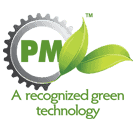Powder metallurgy transforms metal powders into usable metal components and products. These products can significantly lower manufacturing yield losses and guarantee a large reduction in manufacturing costs.
Powdered metal structural components and parts are beneficial by-products of powder metallurgy processes. Due to their unique qualities that cannot be found in other types of metal parts and products, powders have been utilized to their full potential in numerous industrial applications.
What Are Metal Powder Products?
Metal powder products require a higher level of precision that cannot be achieved using conventional manufacturing techniques. Examples of powdered metal products include gears, turbine discs, medical equipment, and components for automobiles and spacecraft.
Powder formulation, shaping, and sintering are the three main procedures to manufacture structural elements out of powdered metal. Machine work, deburring, sizing, or heat treatment are some other processes, depending on the manufacturing need.
Meanwhile, more complex manufacturing requirements utilize other procedures, such as the following:
- Forging
- Hot isostatic pressing
- Metal injection molding
- Sintering using electric current assistance
- Manufacturing using additives (3D printing and/or selective laser sintering)
Compared to traditional machining, these metal powders produce less waste and are flexible enough to create a range of metal and alloy components.
Advantages of Powder Metallurgy
Powder metallurgy provides many advantages over other rival metalworking processes and technologies. These advantages include the following:
- Reduces machining by creating parts with final dimensions or very near to them
- Uses more than 97% of the initial raw material in the completed item to reduce scrap losses
- Allows for a wide range of alloy systems
- Provides exceptional surface finishes
- Produces materials that can be heat-treated for greater tensile strength or wear resistance
- Offers adjustable porosity for filtration or self-lubrication
- Facilitates the production of intricate or unusual shapes that would be difficult or impossible to create using other metalworking techniques
- Is suitable for requirements for moderate- to high-volume component manufacture
- Has long-term performance reliability for complex applications
- Offers lower tool cost
Metals Used in Powder Metallurgy
The durability of the materials used in powder metallurgy varies depending on the requirements. For those using powder metal parts, it is critical to have concrete definitions of the material’s properties to be used before undergoing sintering or other powder metallurgy processes.
The most common materials used in powdered metallurgy include the following:
Stainless Steel
Powder metallurgy frequently uses stainless steel, particularly when corrosion resistance is crucial. Stainless steel in the 300 and 400 series is particularly preferred. Moreover, it is renowned for its substantial iron content, strong construction, and exceptional impact resistance. It also withstands abrasion reasonably well and is ideal for components that must be aesthetically appealing to customers.
Aluminum
Aluminum is a softer but more common metal in powder metallurgy. Its lightweight property makes up for its lack of strength.
This material is commonly processed into powdered metal products used in aerospace and automobiles.
Copper
Copper powder is a preferred material for applications needing great corrosion resistance. However, it is more expensive to produce.
Powdered copper parts are often seen in products like sprinklers.
Nickel
Nickel is a magnetic metal, a unique feature even though it is not an iron-based metal. This makes nickel highly corrosion-resistant but expensive at the same time.
Titanium
Another expensive material for powder metallurgy is titanium. Still, Titanium can be very tough and is perfect for golf clubs and other products that require high corrosion resistance and strength.
Powdered Metal Manufacturing Processes
The creation of metal powders is the initial step in the whole powder metallurgy (PM) process. The following are the four main methods used in powder production:
Solid-State Reduction
Selected ore is crushed — usually combined with carbon — and then passed through a continuous furnace during solid-state reduction. When the carbon and oxygen in the powder are removed in the furnace, a cake of sponge metal is left behind.
This cake is crushed, cleaned of all non-metallic material, and sieved to form a powder. The purity of the powder depends on the purity of the raw components because no refining process is involved.
Atomization
This process is used commercially to produce iron, copper, alloy steels, brass, bronze, and low-melting-point metals like aluminum, tin, lead, zinc, and cadmium. During the process, the metal is quickly divided into small droplets and frozen before the drops of molten metal come into contact with one another or a solid surface.
Typically, high-energy jets of gas or liquid are used to contact a thin stream of molten metal to cause it to disintegrate. In some cases, atomization is also used to produce tungsten, titanium, rhenium, and other high-melting-point metals.
Electrolysis
Copper is the main metal manufactured through electrolysis. This process can turn metals into a spongy or powdery state. Iron, chromium, and magnesium powders are also made by electrolysis.
Due to their high energy expenditures, electrolysis is typically only used on high-value powders, including copper powders with high conductivities. High-purity and high-density powders can be produced by adding additional processing steps such as washing, drying, reducing, annealing, and crushing.
Chemical
Chemical powder treatments include heat degradation, solution precipitation, and oxide reduction. The powders’ qualities vary but can maintain controlled particle size and shape.
Solution-precipitated powders can provide narrow particle size distributions and high purity. Carbonyls are most frequently processed through thermal degradation. These powders feature 99.5% purity after being milled and annealed.
Powder Metal Manufacturing Applications
The production of refractory metals, the building blocks for heat-resistant materials and extremely hard cutting tools, has been made possible through powder metallurgy. Porous self-lubricating bearings are yet another crucial and practical component of parts created from metal powder.
In other words, powder metallurgy products are essential to modern technology, and their importance continues to become significant. Many applications rely on powdered metal parts, including the following:
Automotive Gears
Innovations in creating innovative materials and pressing techniques are closely tied to using powder metallurgy to produce automotive components. Higher densities and strengths can be achieved by pressing, forming, and shaping the large range of materials used in this industry.
Jet Engines
Aerospace turbines must resist high temperatures and a variety of pressures. Thus, turbine discs are made using hot isostatic powder metallurgy and atomized powders. Engine fans, compressors, and turbine blades are also fastened to the turbine disc, which serves as their core.
The high-temperature alloys used to create turbine discs are graded and standardized to the requisite levels. These components are likewise machined and finished to attain the best performance level.
Oil and Gas Industries
Exploration for gas and oil requires hard metal and diamond-cutting equipment — powder metallurgy creates tools from austenitic and stainless steels to fill the need. The materials used to construct valves and manifolds must withstand extreme, dangerous, and demanding situations.
Other applications include the following:
- Porous components like filters
- Tungsten components used in jet engines
- Moving parts for automobiles like clutch plates, connecting rods, camshafts, and pistons rings
- Surgical tools and medical instruments
- Soft and hard magnetic components
- Grinding wheels
- Nozzles for rockets and missiles
- Electrical brushes for motors
- Clock components and parts
- Actuators
- Stepper Motors
- Gear boxes and planetary drives
- Medical devices
World Class Powdered Metal Manufacturing Services From Allied Sinterings
Allied Sinterings recognizes and values the evolving needs of powder metal manufacturing and the increase in demand for high-quality powder metal-driven industries. We are a recognized world leader in manufacturing custom-engineered powder metal products in aerospace, automotive, industrial and manufacturing industries, consumer goods, and medical accessories manufacturing.
Contact us to learn more about our powdered metal manufacturing capabilities and services.



